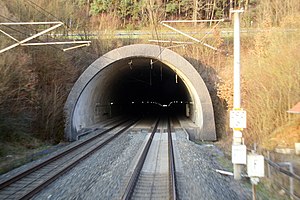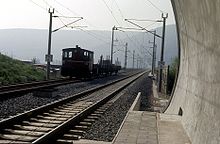One-time mountain tunnel
| One-time mountain tunnel | ||
|---|---|---|
|
South portal of the one-time mountain tunnel, view in north direction. The orientation lighting on both sides makes the long, straight, sloping course of the tunnel recognizable.
|
||
| traffic connection | SFS Hannover – Würzburg | |
| place | Gemünden am Main | |
| length | 1141 m | |
| Number of tubes | 1 | |
| Largest coverage | 130 m | |
| construction | ||
| Client | German Federal Railroad | |
| building-costs | 29 million deutschmarks | |
| start of building | 1981 | |
| completion | October 1982 | |
| business | ||
| operator | DB network | |
| location | ||
|
|
||
| Coordinates | ||
| North portal | 50 ° 4 ′ 30 " N , 9 ° 40 ′ 25" E | |
| South portal | 50 ° 3 ′ 53 " N , 9 ° 40 ′ 26" E | |
The one-time mountain tunnel is a 1,141 m long railway tunnel on the high-speed line from Hanover to Würzburg . It crosses under the Einberg near Gemünden am Main and therefore bears his name. The tube accommodates two tracks, which are planned to be traveled at up to 250 km / h.
In the planning and construction phase, the tunnel was also referred to as Object 27 .
course
The north portal of the tunnel at route kilometers 289, the south portal at route kilometers 290.6. During the construction phase, the north portal was at construction kilometers 272.8, the south portal at construction kilometers 273.9. The north portal connects directly to the southern abutment of the Schaippach Sinntal Bridge .
The route lies in the northern part of the tunnel in a large arc of 32,000 m radius. 400 m from the north portal (former construction kilometer 273.2) the tunnel runs in a straight line to the south portal. The maximum overburden is 130 m. The gradient rises, towards the south, initially at 8.05 per mille and at the former construction kilometer 273.700 it reaches a change in inclination, which is followed by a gradient of 12.5 per mille.
The Gemünden Main Valley Bridge joins the tunnel to the south, and a longer section of open stretch to the north.
In the vicinity of the south portal, the route crosses federal highway 26 on a three-span, 45 m long bridge.
history
planning
The planning status from the end of 1977 provided for a length of 1135 m for the structure. While the elevation corresponded to the profile realized later, a right-hand bend with a radius of 28,000 m was planned in the northern area of the tunnel.
The construction work was awarded on December 17, 1980 to a consortium of the companies Bilfinger + Berger and Universale , which employed around 60 people at the start of construction. The structure was one of the first structures on the new line to be awarded.
When construction began, the breakthrough was scheduled for December 4, 1981, and completion - after a construction period of 90 weeks - in September 1982. The planned length was 1127 m.
construction
Construction work began in December 1980 (construction of the Sinnberg tunnel also began in the same month ). The breakthrough was expected on December 4, 1981, the name day of Saint Barbera, in early 1981. Final completion was expected in September 1982, 90 weeks after construction began. The planned costs were 29 million Deutschmarks.
The tunnel was on May 22, 1981 struck . Carola Koch, the wife of the Federal Railroad President Peter Koch, took over the sponsorship. When the tunnel was opened, she symbolically signed a certificate for the first demolition. The Bavarian Minister of Economic Affairs and Transport Jaumann and Kurt Völker, the first mayor of Gemünden, were among the other guests . A total of around 5,000 guests (500 according to other sources) attended the celebrations.
The tunnel attack on May 22, 1981 was celebrated by the then Federal Railways as the official start of construction in the southern section (Fulda-Würzburg), although the Sinntal Bridge in Schaippach had been under construction since October 1980 and the Sinnberg tunnel officially three months earlier, on February 25, 1981 had been posted. The Burgsinn depot was also already under construction.
The planned length was 1,127 m, the planned construction volume was 29 million D-Marks (around 15 million euros ). A usable cross-section of 86 m² was created, with an excavated cross-section of 106 m².
The drive was carried out from south to north, with a short counter drive from the north. The tunnel was largely driven by red sandstone . First the dome was driven forward; The bench followed in a wake of 80 to 100 meters . In the combined blasting and excavator drive, an average daily drive performance of 6 m was reported. The approximately 234,000 m³ of the tunnel excavated material was heaped flat in front of the south portal to enable a smooth transition to the neighboring Main Valley bridge. To counteract an impending vole plague on the railway embankment, landing poles for buzzards were set up.
The breakthrough took place on February 4, 1982 at the north portal. The tunnel godmother triggered the last explosive shot. A three-meter-thick red sandstone wall was blown up 35 m deep in the mountain with 25 kg of explosives.
It was the first breakthrough on the new line. At that time, four more tunnels on the line were under construction.
No evangelical clergyman was present when the tube was struck and broken through. The Würzburg Dean Martin Elze justified this with the fact that “the Protestant church should not identify with a project” that “involves such interventions in nature and the environment in the area of the Main Valley (...).” The Protestant church was open a good dozen of the approximately 25 tunnel opening or breakthrough celebrations were not represented.
The tunnel was completed in October 1982. The shell of the tunnel was temporarily used as a shortcut by walkers in the direction of the Sinntal.
business
As part of the ICE world record run on May 1, 1988 , the InterCityExperimental test train north of the north portal, in the Sinntal (route km 287.956), set a world record for rail vehicles at a speed of 406.9 km / h.
technology
As one of the first railway tunnels in Germany, it was given a slab track (type Rheda ) instead of a conventional ballast superstructure.
There are two block markers in the tunnel to the south.
Web links
Individual evidence
- ↑ Deutsche Bundesbahn, Federal Railway Directorate Nuremberg, Project Group H / W South of the Bahnbauzentrale (publisher): New line Hanover - Würzburg: Mühlberg Tunnel I. Driving, expansion, equipment and costs. Brochure, September 1983, 34 pp., 25
- ↑ a b c d e f g h i Deutsche Bundesbahn, Federal Railway Directorate Nuremberg, Project Group H / W South of the Bahnbauzentrale (publisher): Start of construction on the southern section of the new Hanover - Würzburg line in Gemünden am Main. May 22, 1981 . Press release, May 1981.
- ↑ a b c Helmut Sturzebecher, Aubel: One-time mountain tunnel: attack on May 22, 1981 . In: bb aktuell (house journal of Bilfinger + Berger Bauaktiengesellschaft), issue 3, 1981, pp. 19-23
- ↑ a b K. G. Baur: Fulda − Würzburg and back . In: Eisenbahn-Kurier , No. 205, October 1989, ISSN 0170-5288 , pp. 32-37.
- ↑ Deutsche Bundesbahn, Federal Railway Directorate Nuremberg, Project Group H / W South of the Bahnbauzentrale (ed.): New Hanover - Würzburg line. Southern section. Realization status July 15, 1981. Illustrated book, Nuremberg, 1981.
- ^ Helmut Maak : The draft of the new Hanover - Würzburg line, section of the Hessian / Bavarian border - Würzburg . In: Die Bundesbahn , year 53 (1977), issue 12, pp. 883-893, ISSN 0007-5876
- ^ A b Helmut Maak: New Hanover – Würzburg line, start of construction in the southern section . In: The Federal Railroad . Vol. 57, No. 10, 1981, ISSN 0007-5876 , pp. 801-806.
- ↑ a b c d e Construction of the One Mountain Tunnel, work around the clock . In: Wir , June 1981 edition, p. 1 f.
- ↑ Helmut Maak: Timeline of implementation . In: Gerd Lottes (Ed.): On new rails through Spessart and Rhön . Hans-Christians Druckerei, Hamburg, 1992, without ISBN, ( Nature and Technology , Volume 6) pp. 65–68.
- ^ Gunther Ellwanger: New lines and upgraded lines of the Deutsche Bundesbahn in the public eye . In: The Federal Railroad . Vol. 57, No. 10, 1981, ISSN 0007-5876 , pp. 769-775.
- ↑ a b Report of the first tunnel breakthrough on the new Hanover – Würzburg line . In: Railway technical review . 33, No. 4, 1982, p. 172 f.
- ^ Karl Kagerer: The new line in the landscape . In: Gerd Lottes (Ed.): On new rails through Spessart and Rhön . Hans-Christians Druckerei, Hamburg, 1992, without ISBN, ( Nature and Technology , Volume 6) pp. 83–94.
- ^ Deutsche Bundesbahn, Federal Railway Directorate Nuremberg, project group Hanover – Würzburg South of the railway construction center (publisher): New line Hanover – Würzburg. The southern section Fulda – Würzburg , brochure (40 pages), April 1986, page 37
- ^ Gunther Ellwanger: New lines and express services of the German Federal Railroad. Chronology. In: Knut Reimers, Wilhelm Linkerhägner (Ed.): Paths to the future. New construction and expansion lines of the DB . Hestra Verlag Darmstadt, 1987, ISBN 3-7771-0200-8 , pp. 245-250
- ↑ a b First tunnel breakthrough on the new DB lines . In: DB Deine Bahn , issue 4/1982, p. 227.
- ↑ DB in the picture . In: DB Deine Bahn , issue 4/1982, p. 236.
- ↑ Helmut Maak: The tunnel construction . In: Gerd Lottes (Ed.): On new rails through Spessart and Rhön . Hans-Christians Druckerei, Hamburg, 1992, without ISBN, ( Nature and Technology , Volume 6) pp. 45–52.
- ↑ Pastors avoid tunnels . In: Süddeutsche Zeitung , No. 238, 1984, ISSN 0174-4917 , p. 23.
- ↑ Belter: Tunneling in quick succession . In: Der Eisenbahningenieur , 34 (1983), Heft 1, p. 37
- ↑ Joachim Seyferth: The new lines of the German Federal Railroad ( rail book 1) . Josey-Verlag, Wiesbaden 1983, ISBN 3-926669-00-4 , p. 43.
- ^ Jürgen Hörstel, Marcus Niedt: ICE - New trains for new routes . Orell-Füssli-Verlag, Zurich / Wiesbaden 1991, pp. 105-107, ISBN 3-280-01994-X
- ↑ Wolfgang Harprecht, Friedrich Kießling, Reinhard Seifert: "406.9 km / h" - world record on the rails - energy transmission during the record run of the ICE of the DB . In: Electric Railways , Volume 86, Issue 9/1988, p. 270
- ↑ Heinz Dürr , Knut Reimers (Ed.): High-speed traffic . 1st edition. Hestra-Verlag, 1991, ISBN 3-7771-0234-2 ( Yearbook of Railways , Volume 42), p. 123
- ↑ Klaus-Dieter Schwendener: Partial renewal 97080 WRSTW SFS 1733 in the RB Süd G016180176. (PDF) DB Netz AG, July 25, 2019, p. 9 , retrieved on December 10, 2019 (file Annex 15 BAst_Teilernlassung Stw 1733.pdf in ZIP archive 19FEI40778_Vergabeunterlagen_Zwischenstand.zip ).


